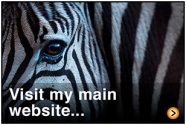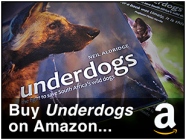I’ve heard them called necklaces, nooses and ASBO’s (a reference to the electronic tags used to curb anti-social behaviour in the United Kingdom) but isn’t it time we learned to love the radio collar? These devices (which include tags for whales and harnesses for birds) have allowed researchers to record essential and surprising information about animal behaviour for years. Our understanding of the natural world would not be what it is without this technology yet many conservationists, wildlife lovers and photographers continue to turn their noses up at them. What I want to know is can the radio transmitter’s role in solving wildlife crime cases – as we saw recently recently in the case of an unfortunate Scottish golden eagle – help to convince the remaining detractors?
I would not have been able to capture the photographs in my African wild dog book Underdogs were it not for the radio collars worn by several wild dogs on various Southern African reserves. These endangered carnivores regularly cover such great distances that they were recently reclassified by the UN as a migratory species. The vital efforts of the researchers I worked alongside simply would not be possible without this technology. Without it, finding wild dogs would be like searching for a needle in a haystack. Radio collars do not only allow researchers to track the movements of animals, they also allow researchers to find their study animals quickly for observation and other crucial work.
The introduction of GPS technology has both improved the efficiency of wildlife tracking and research as well as gifted us some mind-blowing insights into the movements of animals. We now know that African wild dogs disperse over distances greater than 450 kilometres to form new packs and that great white sharks will make the 11,000 kilometre migration between South African shores and the waters off Australia. The findings from research projects where GPS tracking has been utilised helps to broaden our thinking as conservationists and to inform protection policy both locally and collaboratively. The BirdLife Flyways Programme is a great example of how the mapping of migratory movements of species by using GPS technology can allow for a more evidence-based and targetted approach to conservation across borders and promote the safe passage of species.
One additional benefit of tracking technology that surprises many people (and one which I hope will help to convince those who continue to question the merits of this conservation lifeline) is the increased ability to prevent and solve wildlife crime. Radio tracking collars and transmitters can act as a deterrent to would-be persecutors. Although, sadly, a GPS collar was not a deterrent in the case of this magnificent free-roaming lion that was shot on a farm near South Africa’s border with Botswana in 2009, the signal from the collar did lead concerned researchers to the crime scene. In Scotland recently, RSPB staff were able to use GPS data to piece together the final movements of a golden eagle found with two broken legs. The data secured from the GPS transmitter worn by the young eagle, together with the results of the post-mortem, helped the RSPB to come to its conclusion that the eagle had been the victim of persecution.
The recorded persecution of golden eagles in Scotland is believed to be dropping. Surely it is now time to appreciate the role that technology – alongside relationship management, education, habitat restoration, control of invasive species and policy review – plays in such success stories? It could well be that you already recognise and appreciate all of the science but just can’t get the thought out of your mind that a wild dog wearing a collar looks too much like your dog at home. If that is the case, when you next catch Rover humping the sofa and find yourself driving Fido to the groomers, challenge yourself to consider your perception of what makes an animal wild. Think about the sheer number of creatures that are in decline and struggling to find their place in our developed world and ask yourself if the fitting of a radio transmitter that could help to save a species really makes an animal less wild and more like Rover.
What I hope, more than anything, is that you won’t settle on the fallacy that keeping all of nature looking pretty and picture perfect is somehow more important than improving our understanding of the natural world and our ability to conserve it.








